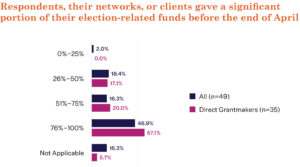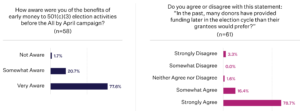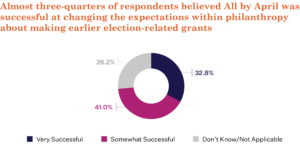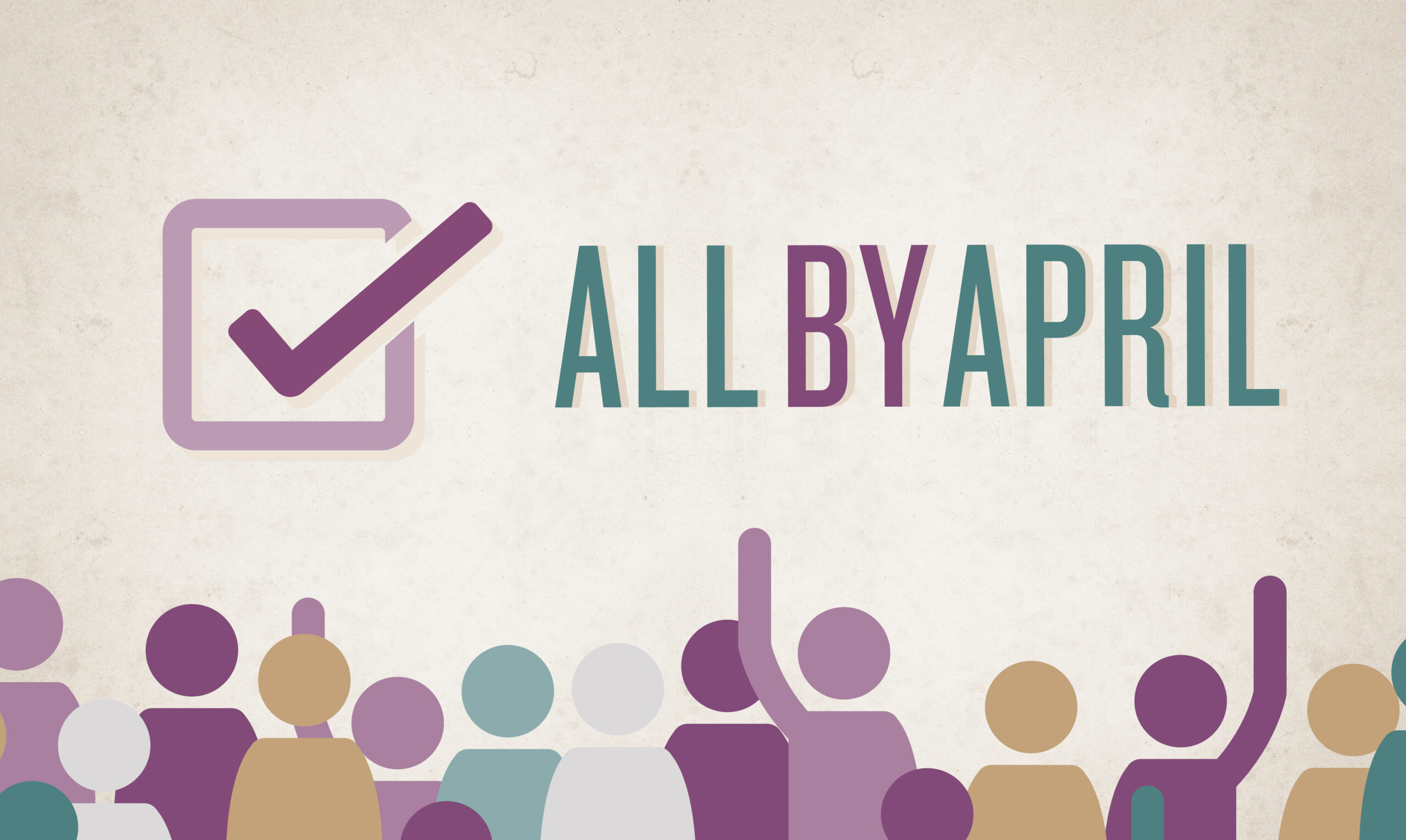Earlier this year, Democracy Fund joined with funders from across the philanthropic community to commit to making their election-related grants by the end of April. The All by April campaign attracted 174 signers — including foundations, donor networks, advisors, and individual donors — who committed to move funds earlier in the year, simplify grant processes, and encourage their peers to do the same.
By providing early financial support, All by April aimed to empower nonpartisan, nonprofit organizations to plan and execute their election strategies more effectively, build out programs at lower costs, and engage voters earlier in the election cycle. We are proud to share the results from this campaign and outline how funders can carry forward the lessons into their ongoing election-related grantmaking.
The Success of All by April
To understand the impact of the All by April campaign, Democracy Fund collaborated with Grassroots Solutions on an evaluation. Our topline findings include:
1. The campaign mobilized at least $155 million.
Of the 174 signers of the campaign, 60 percent were direct grant makers and 40 percent were groups that work with funders like donor advisors, intermediaries, and funder affinity groups. Forty-seven of the funders and individual donors provided data on their giving between January and April of 2024. They reported making $79 million in new 501(c)(3) grants for election-related work and moving up $61 million in scheduled grant payments so that grantees would have access to funds earlier in the year. The campaign’s message also reached groups that were not able to sign onto the campaign (often due to their organization’s policy on signing public commitments). Entities that didn’t sign the campaign but reported that it still influenced their giving reported $13.7 million in new grants and $3.25 million in payments moved up to the first four months of 2024. In total, the campaign mobilized at least $155 million in election-related support.
“AbA inspired us to make additional gifts — in addition to the 2024 and multi-year funding we had already provided — and to do so before the end of April.”
— All by April Participant (Grantmaker)

2. The majority of All by April signers reported that they changed their plans for giving in 2024 because of the campaign.
The campaign’s deadlines and structure created the motivation that moved signers to action – especially among those who were newer to election-related giving. Among direct grantmakers in the survey, 57 percent gave between 76-100 percent of their funding for elections work by April. Those who did not change their giving based on All by April reported that they had already planned to move their funds early or faced internal barriers that prevented them from doing so.
“Once we had our list of grantees, we might have spent more time obsessing over allocation amounts. Having taken the pledge helped inspire us to stop worrying and get the money moving.”
— All by April Participant (Grantmaker)
3. The campaign changed expectations about how philanthropy can support election-related work.
Nearly all of the campaign signers (98%) reported that they were already aware of the benefits of early money for election-related work before the campaign began, but they lacked the motivation and urgency to respond to the field’s need. Signers who were not direct grantmakers, but who advise donors or convene donor networks, reported that the campaign created a “movement wide” framing that gave them the language to encourage earlier giving among their clients and members.

“It allowed me to have conversations with peer funders about the importance of moving early. It created a very helpful (even if somewhat artificial) deadline.”
— All by April Participant (Donor Advisor)
“We used the All by April frame to push our entire donor community for larger, earlier giving, and to make the case for c4 money also. it was helpful to have “movement wide” framing, coordination and momentum to support the work we would have done.”
— All by April participant (Philanthropic Network)

We are grateful to all of the campaign signers who committed to meet the urgent needs of the field when the funds would be most useful. We are especially grateful to the signers who participated in the evaluation and shared their funding data. This transparency allows us all to learn together and continue to improve the way we support free, fair, and representative elections.
Exploring Practices to Move Money Faster
The All by April campaign evaluation revealed that some funders need to make intentional changes to their practices to meet the needs of the field. Funders reported needing to move their timeline for considering new grants or shift other internal processes — like grant amendment requirements — in order to move up payments.
At Democracy Fund and amongst survey respondents, we noted several practices that helped funders move funds quickly:
- Streamlining the grant amendment process. Funders cut internal red tape and asked that grantees only submit an updated budget to process an amendment.
- Adopting a shorter renewal application. A shorter application helped to avoid asking grantees to send information their current funders already had.
- Starting in 2025, planning to default to making payments for election-related grants in Q1 of each year.
Funders may also consider other established time-saving practices like accepting applications that grantees have prepared for other funders or funding intermediaries who may have existing grantee relationships and can regrant money into state and local groups.
Looking Ahead: Funders Need to Sustain the Field Between Elections
Our grantees are on the frontlines of the 2024 election, doing everything they can to ensure it is free, fair, and representative. But we know their work is not over on Election Day. Anti-democracy forces don’t defund their infrastructure after every election cycle, forcing groups to downsize and lose momentum — and we shouldn’t either.
Yet many grantees see a financial cliff after November. This sudden dropoff in funding threatens their ability to resist the authoritarian playbook, fuel a governing agenda, and build durable power in service of creating a more inclusive, multi-racial democracy.
To ensure we are meeting these needs, we will be announcing a new campaign next week, called “Election Day to Every Day” to ensure our pro-democracy field is ready for any and all scenarios that lie ahead in the post-election period. We must keep our foot on the gas and make sure our field partners know that we have their backs not only on Election Day, but Every Day that follows.
